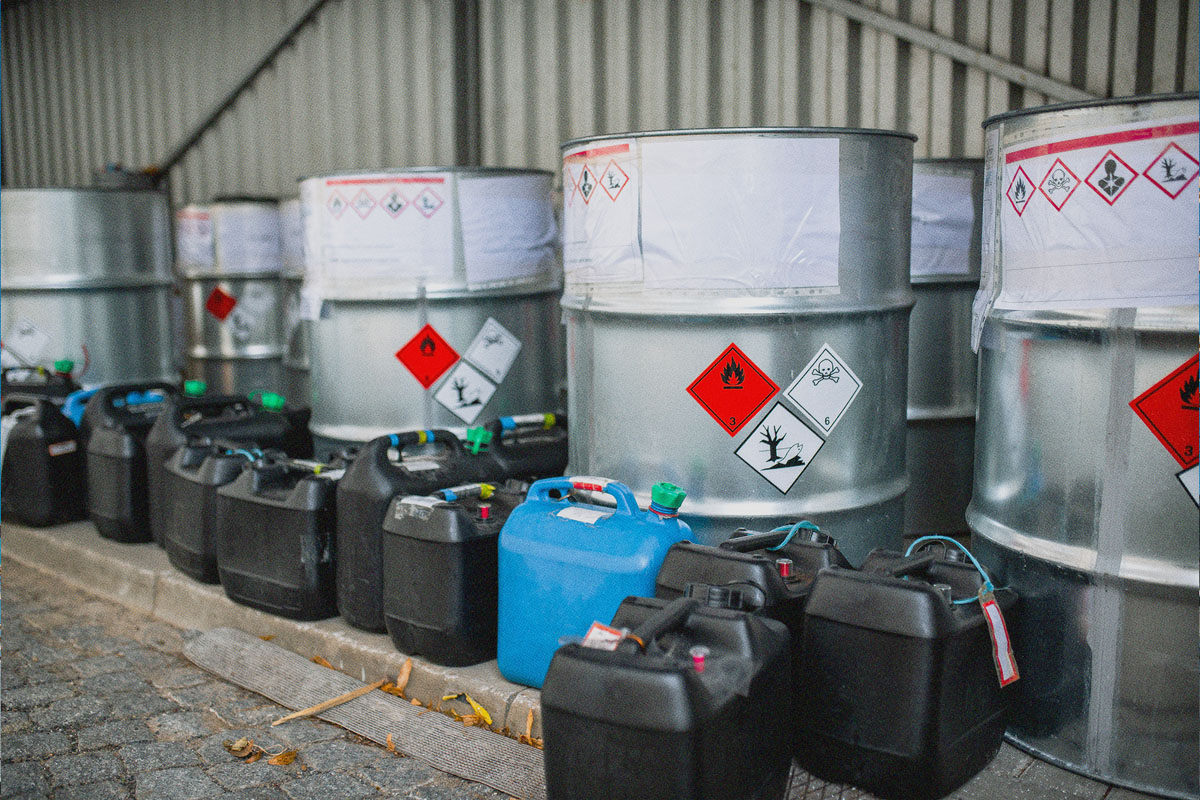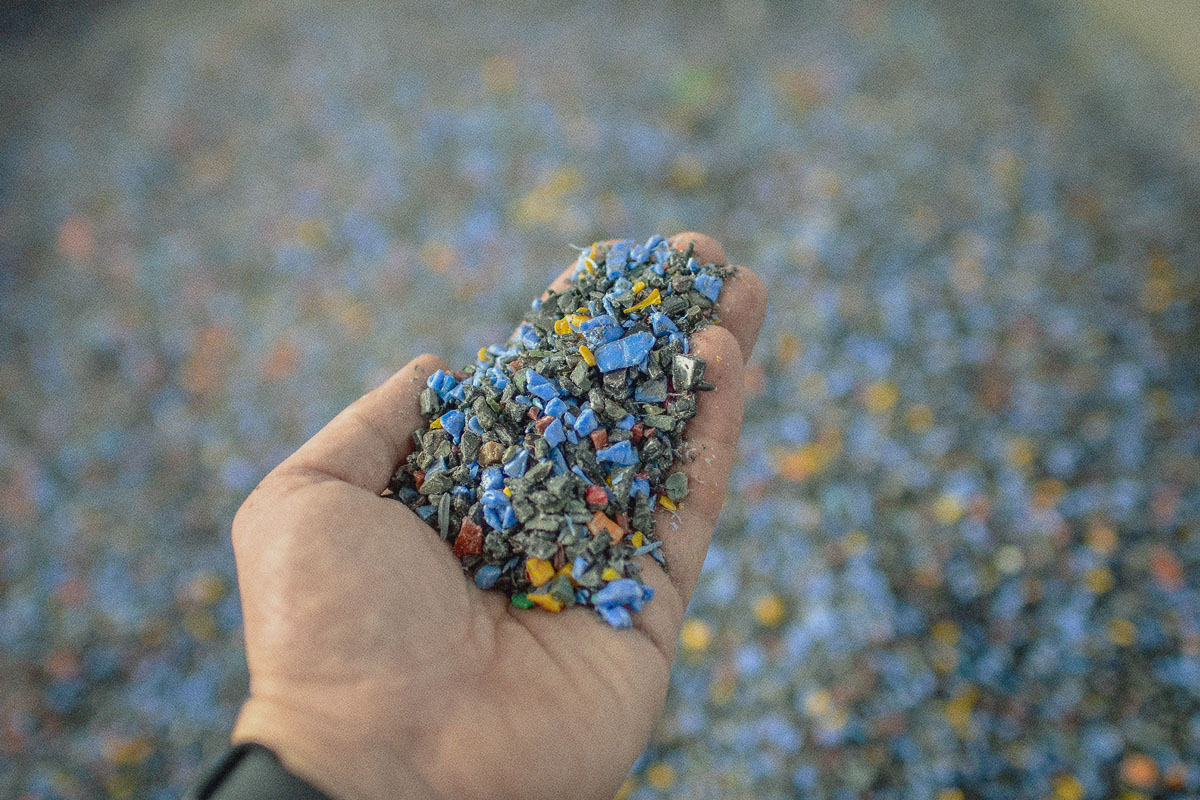 READ HABITABLE’S NEW REPORT
READ HABITABLE’S NEW REPORTWatch ChemSec’s skit about the SIN List, to learn why hazardous chemicals should be removed from products due to the health and environmental risks they present.
ChemSec’s Marketplace connects products like this car seat with safer alternatives to hazardous chemicals, offering a platform for them to find better matches and reduce their environmental impact.

Phase 2 of this report is the first of its kind plant-by-plant accounting of the production, use, and releases of chlorine and related pollution around the world. It is intended to inform the efforts of building product manufacturers to reduce pollution in their supply chains.
Chlorine is a key feedstock for a wide range of chemicals and consumer products, and the major ingredient of polyvinyl chloride (PVC) plastic. The report includes details aboutthe production technologies used and markets served by 146 chlor-alkali plants (60 in Asia) and which of these plants supply chlorine to 113 PVC plants (52 in Asia). The report answers fundamental questions like:
- Who is producing chlorine?
- Who is producing PVC?
- Where? How much? And with what technologies?
- What products use the chlorine made in each plant?
Key findings include:
- Over half of the world’s chlorine is consumed in the production of PVC. In China, we estimate that 74 percent of chlorine is used to make PVC.
- 94 percent of plants in Asia covered in this report use PFAS-coated membrane technology to generate chlorine.
- In Asia the PVC industry has traded one form of mercury use for another. While use of mercury cell in chlorine production is declining, the use of mercury catalysts in PVC production via the acetylene route is on the rise. 63 percent of PVC plants in Asia use the acetylene route.
- 100 percent of the PVC supply chain depends upon at least one form of toxic technology. These include mercury cells, diaphragms coated with asbestos, or membranes coated with per- and polyfluoroalkyl substances (PFAS), used in chlorine production. In PVC production, especially in China, toxic technologies include the use of mercury catalysts.
Supplemental Documents:

The Global Chemicals Outlook II assesses global trends and progress in managing chemicals and waste to achieve sustainable development goals, with a focus on innovative solutions and policy recommendations.

Phase 1 of this report is the first of its kind plant-by-plant accounting of the production, use, and releases of chlorine and related pollution around the world. It is intended to inform the efforts of building product manufacturers to reduce pollution in their supply chains.
Chlorine is a key feedstock for a wide range of chemicals and consumer products, and the major ingredient of polyvinyl chloride (PVC) plastic. The report includes details about the largest 86 chlor-alkali facilities and reveals their connections to 56 PVC resin plants in the Americas, Africa and Europe. (The second phase of this project will inventory the industry in Asia.) A substantial number of these facilities, which are identified in the report, continue to use outmoded and highly polluting mercury or asbestos.
Demand from manufacturers of building and construction products now drives the production of chlorine, the key ingredient of PVC used in pipes, siding, roofing membranes, wall covering, flooring, and carpeting. It is also an essential feedstock for epoxies used in adhesives and flooring topcoats, and for polyurethane used in insulation and flooring.
Key findings include:
- In the United States, the chlor-alkali industry is the only industry that still uses asbestos, importing 480 tons per year on average for 11 chlor-alkali plants in the country (including 7 of the 12 largest plants).
- The only suppliers of asbestos to the chlor-alkali industry are Brazil (which banned its production, although exports continue for the moment) and Russia, whose Uralasbest mine is poised to become the sole source of asbestos once Brazil’s ban is in place.
- The US Gulf Coast is the world’s lowest-cost region for production of chlorine and its derivatives. It is home to 9 facilities that use asbestos technology, and some of the industry’s worst polluters including 5 of the 6 largest emitters of dioxin.
- One Gulf Coast facility has been found responsible for chronic releases of PVC plastic pellets into the Gulf of Mexico watershed.
- The US, Russia and Germany are the only countries in this report that allow the indefinite use of both mercury and asbestos in chlorine production.
- The world’s two largest chemical corporations – BASF and DowDuPont – have not announced any plans to phase out the use of mercury and asbestos, respectively, at their plants in Germany.
- Chlor-alkali facilities are major sources of rising levels of carbon tetrachloride, a potent global warming and ozone depleting gas, in the earth’s atmosphere.
- Far more chlorinated pollution, such as dioxins and vinyl chloride monomer, is released from chlor-alkali plants that produce feedstocks for the PVC industry than from plants that produce chlorine for other uses.
Supplemental Documents:

The Future of Petrochemicals report explores the role of the petrochemical sector in the global energy system and its increasing significance for energy security and the environment, highlighting the need for attention from policymakers.
While attending a 2018 meeting of U.S. EPA’s National Environmental Justice Advisory Council (NEJAC) in Boston, I heard the testimony of Delma and Christine Bennet. They live in Mossville, LA, amidst what is likely the nation’s largest concentration of PVC (polyvinyl chloride) manufacturing facilities. I was there to present the findings of HBN’s inventory of pollution associated with the chlorine/PVC supply chain.
Our study found, among other things, that the Gulf Coast region (which includes Mossville) is home to nine facilities that use outmoded asbestos technology, and home also to some of the industry’s worst polluters: Five of the six largest emitters of dioxins––a long lasting, extremely toxic family of hazardous waste that causes cancer and many other health impacts, are located there. The Bennets reminded the EPA that according to studies by a division of the Centers for Disease Control, Mossville residents have three times higher levels of dioxin in their blood than average Americans, and the dioxin levels found in their yards and attic dust exceed regulatory standards typically used for toxic waste remediations of industrial sites. Even the vegetables in their gardens tested positive for dioxin.
When I think about why we fight so hard to exclude PVC from any palette of green, healthy, or sustainable building materials, I think first of people like Delma and Christine. I then think about the many non-profits, government agencies, and private enterprises dedicated to recycling. Way back in the 1990’s, the industry Association of Plastic Recyclers declared PVC a contaminant to the recycling stream. A generation later, a 2016 study by the Circular Economy evangelist Ellen MacArthur Foundation called out PVC packaging for global phase-out, citing low recycling rates and chemical hazard concerns. Much of the concern about PVC packaging is driven by worries about ocean pollution. HBN’s study found that at least one U.S. PVC manufacturer is routinely dumping tons of PVC pellets into local waterways and refusing to stop even after being ordered to do so by the state of Texas.
The list goes on. Our report documents the types of industrial pollution in addition to dioxin that could be reduced or avoided by a switch to more recyclable plastics that are not made with the chlorine that is an essential ingredient of PVC, including ozone depleting and potent global warming gasses. HBN’s earlier studies have documented the hazards posed by legacy pollutants that are returning to our consumer products in recycled PVC content––heavy metals such as lead, and endocrine-disrupting plasticizers known as phthalates.

There is a better way.
There is virtually no use of PVC in building products that could not be replaced with another plastic or other material. Indeed, from siding, to wallpaper, to window frames, PVC has displaced materials that are more recyclable, such as aluminum and paper. Because the industry is not held accountable for the environmental health damages wrought in places like Mossville, PVC has artificially low costs that present barriers to entry, or inhibit market expansion of less hazardous, more sustainable alternatives.
That is why PVC should not be part of any building, or any building rating system, that claims to advance environmental and health objectives. It’s not green. It’s not healthy. It’s not sustainable. It’s just cheap––for us. Because folks like Delma and Christine Bennet pay the true cost.

Know Better
Learn more about the implications of chlorine as a feedstock in plastics in HBN’s Chlorine and Building Materials report.
Not all recycled content materials are created equal – especially when it comes to recycled plastics.
In a report released by StopWaste and the Healthy Building Network, we take an in-depth look at the health implications, supply chain considerations, and potential to scale up recycling of the world’s most common plastic: polyethylene (aka PE). [1] This report, Post-Consumer Polyethylene in Building Products, is the latest installment in our Optimizing Recycling series.
Polyethylene is a material widely used in product packaging, beverage containers, and myriad consumer products. High Density Polyethylene (HDPE), Low Density Polyethylene (LDPE), and Linear Low Density Polyethylene (LLDPE) are all readily recyclable in California. Polyethylene plastic scrap bottles and plastic bags usually have minimal contents of concern and are easily processed into feedstock for new products, including building materials. Despite the great potential for recovery of PE, sizeable barriers stand in the way of a lot more recycling.
The explosive growth in virgin ethylene production on the U.S. Gulf Coast, driven by cheap energy, has meant that most post-consumer scrap PE is either landfilled, incinerated, or sent overseas for processing. [2]

Industry trends in recycling collection technology are also undermining the value of post-consumer polyethylene feedstocks. Pipe and plastic lumber manufacturers in the U.S. require supplies that have minimal amounts of contaminants such as volatile residual substances in packaging and other types of plastics. Yet proportionally less “good material” is coming out of the plastic waste recycling stream due to the rising use of municipal single stream recycling over the past decade. Mixed and low quality scrap materials that come from single-stream recycling centers are more likely to be exported than sorted and screened for high-quality polyethylene scrap. As a result, more recovered plastic bags are exported than processed domestically. [3]
Additives used for plastics can turn into contaminants when recycled. As seen with other recycled content materials, feedstocks with less contamination have an increased potential for recyclability as well as increased value to purchasers. [4] For PE, contaminants come in the form of residual materials from packaging (residue from bottles that contained pesticides, for example), or from additives used in manufacturing to achieve certain product characteristics. Perhaps the most problematic additive to PE products are so-called biodegradation additives used in plastic packaging. These additives (but not the rest of the plastic) degrade when exposed to sunlight or other environmental conditions. When these products are collected and used as post-consumer recycled feedstocks in products like pipes and decking, however, these additives can lower the reliability and value of a manufacturer’s product. This is why, in our report, we recommend that plastic manufacturers stop using degradability additives in all new polyethylene.
SOURCES
- Polyethylene sales accounted for 35% of all USA plastic resin sales in 2014. The next most common resins, polypropylene and polyvinyl chloride, accounted for 15 percent and 14 percent, respectively. (American Chemistry Council. “2015 Resin Review,” April 2015.)
- In 2005, the Healthy Building Network and the Institute for Local Self-Reliance examined the market for lumber made from recycled plastic. The report rated fourteen plastic lumber products as “most environmentally preferable” because they contained only polyethylene plastics and, according to the manufacturer at the time, at least 50% of the polyethylene was from post-consumer sources. (Platt, Brenda, Tom Lent, and Bill Walsh. “The Healthy Building Network’s Guide to Plastic Lumber.” Institute for Local Self-Reliance, June 2005. https://www.greenbiz.com/sites/default/files/document/CustomO16C45F64528.pdf.) At least eight of these fourteen products remain on the market, but current literature reveals that most if not all have decreased post-consumer content in favor of pre-consumer (factory-generated) scrap or even virgin polyethylene. Plastic lumber products listed in the report that are still on the market include: SelectForce; PlasTEAK; TRIMAX; American Plastic Lumber’s HPDE decking; Perma-Deck Advantage+; Eco-Tech; Enviro-Curb; and MAXiTUF. Resco Plastics, manufacturer of MAXiTUF plastic lumber, explains, “Due to the current price increases for our raw material, Resco Plastics, Inc. is no longer able to guarantee its post consumer content.” (Resco Plastics Incorporated. “Plastic Lumber Warranty,” 2016. http://rescoplastics.com/warranty/.)
- Plastic scrap exports to Asia have soared since 2000. This trend continued through 2013, the most recent year for which data are available from the Society of the Plastics Industry. Of the plastic film collected for recycling in the US, only 42 percent was processed in the U.S. or Canada. Shippers exported the remaining 58 percent. (Taylor, Michael D. “The State of Plastics Recycling in the U.S.” presented at the 11th China International Forum on Development of the Plastics Industry & China Plastics Recycling/ Reutilization Forum, Yuyao, China, October 2015. http://www.slideshare.net/mdairtaylor/the-state-of-plastics-recycling-in-the-us.)
- See our report Optimizing Recycling: Criteria for Comparing and Improving Recycled Feedstocks in Building Products for more on how additives and contaminants can affect common post-consumer recycled feedstock materials markets.
When one waste disposal option closes, another inevitably opens.
A half-century ago, the federal government started regulating solid wastes and preventing rampant dumping in the woods, ocean, and unlined dumps. Then the so-called Not-In-My-Backyard (NIMBY) movement of the 1970s and 1980s prevented scores of landfills and incinerators from being permitted across the country, just as existing disposal sites were reaching capacity. There were also spectacular failures at waste sites that made headlines. Coal ash ponds failed, releasing contaminated waste into rivers and drinking water. Giant piles of tires caught on fire, and came to symbolize the crisis of growing piles of waste.
In response, environmental agencies partnered with waste generators like the coal power and tire industries to find ways to reduce the amount of their wastes going to landfills. The US Environmental Protection Agency developed an option called “beneficial use,” in which these wastes could be diverted to build roads, fill old mines, and turn wastelands into golf courses. Some of these “beneficial uses” hit literally close to home; coal waste has been diverted into wallboard and carpet backing, tires into flooring, and contaminated soils into our own backyards, without any regulation.

In two articles, we describe the impacts of this waste management strategy.
“On Tire Wastes in Playgrounds” reveals how chopped up tire mulch is becoming as common as dirt in playgrounds, and why government health agencies are beginning to take action to protect children from exposure to toxic substances in the rubber waste, like polycyclic aromatic hydrocarbons and lead.
“Filled with Uncertainty: Toxic Dirt in Building & Construction” examines the unregulated dirt trade. Our research found that soil and coal ash contaminated with neurotoxic substances have become commonplace construction materials, from structural fill to flower bed topsoil. Contaminated material is often sold as “clean fill” by untrustworthy companies. With no tracking in place, building owners have no idea, and probably don’t think to ask, where their fill is coming from.
Waste has a way of finding the path of least resistance. A void of oversight coupled with numerous government and private sector incentives promoting the use of unregulated recycled content leaves it to responsible architects, designers, contractors and building owners to increase scrutiny of this vast diversion of wastes into our homes, schools, playgrounds and places of business. In the absence of political will, building owners and residents are left to protect themselves. We hope these articles will lead developers, especially of residential areas and playgrounds, to start asking more questions of dirt and fill contractors, beginning with: where did your materials come from, and have they been tested for toxic contaminants?
To breathe, I have to take way too many medicines today – each with their side effects.
I’m an adult. Imagine a child having to wade through all the symptoms and medicines associated with asthma.
Many factors contribute to the development and aggravation of asthma. However, I am wondering whether the installation of PVC flooring in my bathroom and kitchen contributed to the worsening of my breathing.
The floor was laid three years ago. A slow leak under my sink went unnoticed until the downstairs’ neighbor’s ceiling fell. About this time, my life-long respiratory ailments worsened.
Scientists are investigating the relationship between moisture, PVC flooring, and asthma.
In Sweden, a study of 10,851 children found the presence of both floor moisture and PVC significantly increased the risk of asthma.[1] The incidences were higher in multiple family dwellings where a higher percentage of PVC flooring was found.
Many workers in an office building in Finland, over a short period of time, were diagnosed with adult-onset asthma at a rate of about 16 times higher than expected.[2] An investigation uncovered in the office air space high levels of volatile chemicals, such as 2-ethyl-l-hexanol, l-butanol, which are degradation by-products of vinyl. The problem was traced back to damp concrete surfaces below the PVC flooring.
The PVC flooring was removed and surface of the concrete slab warmed up enough to remove the volatiles that had been diffused within. In rooms cleaned up in this manner and floors replaced with ceramic tile, the emissions of the three main volatiles (2-ethyl-l-hexanol, l-butanol, and 3-heptanone) decreased, as did employees’ symptoms and many asthma patients’ needs for medication.

Furthermore, studies have linked dust containing phthalates from homes with PVC flooring with an increase in asthma.
To make it less brittle, PVC is coated with plasticizers called phthalates. These chemicals evaporate and enter the air space where they adhere to dust particles.[3] New research shows that dust from homes containing PVC floors has higher levels of phthalates – particularly di(2-ethylhexyl) (DEHP) – than dust from homes without vinyl floors. One recent case-control study found an association between dust concentrations of phthalates inside homes and asthma, rhinitis and eczema.[4] The presence of PVC flooring in the child’s bedroom was the strongest predictor of respiratory ailments.
Other studies reach similar conclusions,[5] with one recommending “avoidance of PVC flooring in homes with small children” as a simple first step.[6]
Avoiding PVC flooring isn’t difficult, but it’s often disregarded as a cost-cutting measure.
Meanwhile, the costs associated with the increase in rates of asthma keep adding up. According to officials in my home state of Massachusetts, asthma is the number one preventable cost to hospitals.[7]
Prescription costs, doctors’ fees, lost wages due to time off from work for parents of asthmatic children, and the un-quantifiable cost of school absenteeism add up to a hefty burden for families and society.
Alternatives to PVC that are easier on the lungs exist today.
By switching to safer products we could be offering a child the priceless gift of easy breathing.
Guest columnist Niaz Dorry is a veteran activist and writer living in Gloucester, Massachusetts. She works with small-scale, traditional, and indigenous fishing communities in the U.S. and from around the globe to advance the rights and ecological benefits of the small-scale fishing communities as a means of protecting global protect marine biodiversity. In 1998, Time Magazine named Niaz as a Hero For The Planet for this work. Her fisheries articles appear regularly in a range of publications.
SOURCES
- Bornehag, C.G., Sundell , J., Hägerhed , L., Janson, S., and the DBH-study group, “Dampness In Buildings And Health. Dampness At Home As A Risk Factor For Symptoms among 10 851 Swedish Children” (DBH-STEP 1) (2002), SP Swedish National Testing and Research Institute and the International Centre for Indoor Environment and Energy, Technical University of Denmark Karlstad University, Sweden.
- Tuomainen, A., Seuri, M., Sieppi, A. “Indoor Air Quality And Health Problems Associated With Damp Floor Coverings In An Office Building” (2002), Kuopio Regional Institute of Occupational Health, Department of Occupational Hygiene and Toxicology, Kuopio, Finland; Kuopio Regional Institute of Occupational Health, Department of Occupational Medicine, Kuopio, Finland; and, Medivire Occupational Health Center, Kuopio, Finland.
- Katherine M. Shea, MD, MPH, and the Committee on Environmental Health; “Pediatric Exposure and Potential Toxicity of Phthalate Plasticizers.” Technical Report. American Academy of Pediatrics. PEDIATRICS Vol. 111 No. 6 June 2003.
- Carl-Gustaf Bornehag, Jan Sundell, Charles J. Weschler, Torben Sigsgaard, Björn Lundgren, Mikael Hasselgren, Linda Hägerhed-Engman, “The Association Between Asthma and Allergic Symptoms in Children and Phthalates in House Dust: a Nested Case-Control Study, Environmental Health Perspectives, July 15, 2004 (The National Institute of Environmental Health Sciences, National Institutes of Health, U.S. Department of Health and Human Services).
- Ruthann Rudel and Julia G. Brody, Silent Spring Institute, Newton MA; David Camann, Southwest Research Institute, San Antonio, TX; John Spengler, Harvard School of Public Health, Boston, MA; Leo Korn, UMDNJ, New Brunswick, NJ, “Phthalates, Alkylphenol, Pesticides, Polybrominated Diphenyl Ethers, and Other Endocrine Disrupting Compounds in Indoor Air and Dust,” Environmental Science & Technology, September 13, 2003.
- Haumann , T. and Thumulla, J., “Semi Volatile Organochemicals In Indoor Environment – Chlorinated Phosphorus And Organotin Compounds In Material Und House Dust Samples” (2002) Umweltanalytik und Baubiologie, Essen, Germany. AnBUS e.V., Fürth, Germany.
- Remarks of Massachusetts Division of Health Care Finance Policy official at the Massachusetts Department of Public Health’s conference on asthma, March 23, 2002.

 Pollution
Pollution